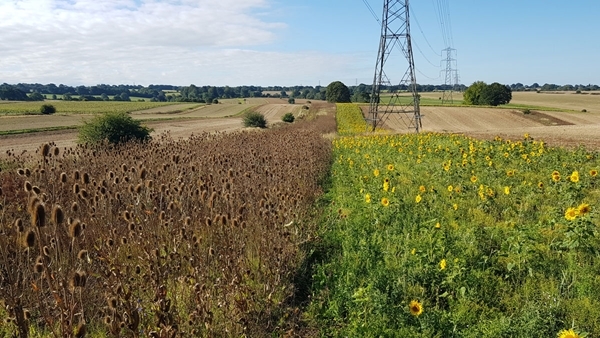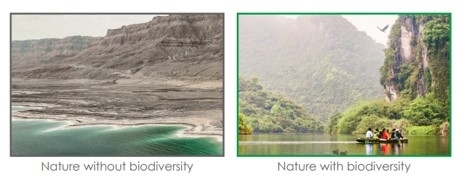
By Henrietta Appleton, GWCT Policy Officer (England)
As the new MPs commenced their tenure at Westminster, the House of Commons Library produced a useful quick read titled “Are we on target for the environment?”. This summarised the current four priority areas identified by the Environment Act 2021 including waste & resources, air quality, water quality, and biodiversity loss.
What does it mean to be “nature-depleted”?
The section on biodiversity loss stated that the UK is one of the most nature-depleted countries in the world as we are in the bottom 10% of nations for biodiversity. This is a regularly cited statement; the new Secretary of State, when announcing the need for change, used it as did the Guardian in its recent article on how to improve our national parks for nature.
But what do we actually mean by nature-depleted, and by what metric is the UK so described?
Understanding the Biodiversity Intactness Index (BII)
Firstly, there is no formal definition of “nature-depleted”. It is a phrase that emerged out of the creation of the global Biodiversity Intactness Index (BII) by the Natural History Museum (NHM). The NHM BII “summarises the change in ecological communities in response to human pressures” such as land use change, population growth, and landscape simplification.
It does this by comparing current biodiversity with a baseline of species from near-undisturbed sites. The BII value, therefore, will decrease as the human influence on natural ecosystems increases. Consequently, according to BII, the UK has just 53% of its original nature left intact, probably due to our long history of population expansion and associated land uses, and is therefore in the bottom 10% of the 240 nations and territories in the world.
Considering the BII for each UK country further demonstrates the influence of human pressures, with Scotland at 56%, Wales 51%, Northern Ireland 50%, and England 47%.
Alternative metrics: Environmental Performance Index (EPI)
Using this definition, there is no argument that we are nature-depleted as our climate and soils mean that our land is highly adapted to food production, with about 70% of our land now farmed.
But this is only one metric, and one which is only focussed on global biodiversity depletion by human activity. An alternative might be the biodiversity metrics within the Environmental Performance Index (EPI) produced by Yale University. Using this metric, our performance is very different. Rather than estimate the area of the UK that is ‘natural’, they use indices based on habitat intactness.
On this basis, we rank 43rd out of 152. And this is just one of 7 different indicators the EPI uses to assess a country’s actions toward retaining natural ecosystems and protecting the full range of biodiversity within their borders.
Overall, for biodiversity, we rank 23rd out of 180, which puts us in the top quartile, not the bottom one - a very different picture indeed. But that does not mean we can be complacent; we know many species are in trouble and the indicator that reports potential extinction risk is still declining (compared to the 2001 baseline).
Defining “nature” and “biodiversity”
A second aspect is to consider what the terms “nature” and “biodiversity” mean. Put simply, nature is defined as all the features, forces, and processes that created the Earth; whilst biodiversity is the variety of life on Earth. The best way to understand this is to imagine nature without biodiversity and nature with biodiversity (see pictures taken from this document (cbd.int)).

The problem is that often when we consider nature, most of us mean plants and animals i.e., biodiversity or wildlife. The terms nature, wildlife, and biodiversity are often conflated, creating considerable confusion and misinterpretation. Technically, wildlife does not include plants, yet probably most of us see it as doing so.
Are we one of the most biodiversity-depleted countries?
The question, therefore, is not whether we are one of the most nature-depleted countries, but whether we are also one of the most biodiversity-depleted countries?
The presence of what we regard as our native plants and animals (biodiversity) requires consideration of our geological and paleoanthropological history. The UK was once part of Europe and much of our land was glaciated at some point. Add to that our long history of population expansion, agricultural ‘intensification’ and industrialisation since the ice age, and it is likely that our naturally occurring biodiversity will have changed and evolved over time in response to these events.
The evolution of biodiversity in the UK
Post-glaciation, trees such as birch would have been one of the first pioneer colonisers, and it is thought that woodland of a sort covered most of our land (probably in a mosaic with grassland, often termed wood pasture). Early settlers would have been nomadic hunter-gatherers with early invaders introducing new species to our shores; for example, the Romans brought hares and rabbits, the former now sufficiently revered to be a Biodiversity Action Plan species in England.
It has been estimated that in the 8th century, woodland covered about 25% of England. As the population grew, food production would have initially been based on a type of slash and burn, and then as permanent communities developed, ‘farming’ emerged through the continuous cultivation of areas. The landscape would have started to look different with a reduction in woodland cover, although until about 1800, woodland had value for building, fuel, and some industries.
Following this, there was a period of intense woodland clearances resulting in about 5% coverage in c1900. There have been further fluctuations in woodland cover in response to public policy, culminating in the current drive to increase woodland cover to meet net-zero ambitions.
Farming and its influence on biodiversity
The type of farming in each era and locality would have been dictated by local conditions, such as climate, aspect, height above sea level, and soil, ultimately resulting in the broad distinction of livestock/mixed farming in the west, and arable farming in the east (although the focus on food production post-war and the use of inorganic inputs has blurred this distinction).
The industrial revolution and the move of many from the countryside to cities merely reinforced the mechanisation of food production. Whilst agriculture and horticulture have been drivers of the introduction of new species to areas, they have also resulted in the homogenisation of species within countries, continents, and biomes.
The impact of human intervention on biodiversity
I appreciate that this is a hugely simplified timeline, but it is merely meant to emphasise that our plants and animals (biodiversity) reflect our history. Almost certainly, the habitat alterations that we humans made to the original wilderness across the UK increased the number of species that our island nation could support through creating a mosaic of different vegetative cover from woodland to wetlands, heathland, grassland, and farmland, and bringing in new species.
Rewilding and its challenges
Some approaches to rewilding seek to take us back to the original state of nature before humans set foot on the British Isles. Such changes at scale due to policy encouragement will inevitably disadvantage those species that have adapted to the existing landscape and are, therefore, likely to initially reduce biodiversity due to a more homogenised landscape, rather than increase it, as seems to be the common belief.
The species present in areas managed through rewilding are likely to change due to natural succession (say from open arable landscape species to scrub and woodland species) and a more homogenous habitat structure will limit the diversity of species that it can attract.
The dilemma of rewilding
This begs the question of rewilding – to which era of our history do we wish to revert? In addition, such an approach needs to be considered alongside the necessity of providing food to our current population if it results in the conversion of substantial areas of productive land.
Outsourcing even more of our food production (given that we now, for example, expect tomatoes, lemons, and strawberries all year round) to countries who may have more nature or biodiversity in order to rewild the land in our country simply shifts the issue elsewhere.
Responding to the biodiversity crisis
The rewilding movement is one response to the biodiversity crisis we face and the perceived failure of existing ‘traditional’ approaches to conservation to address this crisis. The wild bird and composite wildlife indices used in the Outcome Indicator Framework for the 25-year Environment Plan all show declines.
Specialist groups of species (those which require specific habitat conditions arguably created by historic land management practices) have the most prominent decline, and, among birds, farmland birds are in the steepest decline.
The role of GWCT research
GWCT research has demonstrated that the industrialisation of our farming system since the second world war has largely been to blame for the decline in our specialist arable species. Many species, such as corn bunting, skylark, and arable flora, were adapted to the spring sowing, low-yielding cereals of the early 20th century and the cropping rotations that went with it.
The arable weeds attracted insects, which in turn were an important food source for many farmland birds. The cereal provided a protective canopy and the adjacent field margin and hedgerow suitable nesting habitat. The same GWCT research has also identified how these declines can be reversed – alongside commercially farmed land, hence the development of agri-environment scheme options.
Restoring farmland biodiversity
When these habitats are correctly deployed, and additional supporting measures such as supplementary feeding and protection from predation are used where evidence suggests they have a significant benefit, farmland birds can recover significantly – the Allerton project demonstrated a 100% increase.
We estimate that dedicating 15-20% of the farmed area (largely through re-purposing unproductive or difficult areas to farm) to agri-environment schemes should be sufficient to conserve what we have, without a need to go 100% rewilded.
A shift in approach for effective conservation
The failure of ‘traditional’ approaches to conservation more than likely reflects that the top-down approach to agri-environment policy has not resulted in the attention to detail necessary to achieve the results, using all the measures mentioned above.
This new era of “green finance” that recognises the value of wildlife and nature offers hope. However, success will only be achieved if the desire to rely on dictating actions to land managers is abandoned in favour of genuine engagement with land managers.
Conclusion: Is the UK nature-depleted?
So, is the UK nature-depleted? Technically yes if you consider our status from the viewpoint of the BII. But this is only one metric and, frankly, presents a message that suits those who demand substantial public investment in nature recovery projects, such as the rewilding and repurposing of 25% of our land for nature, which will reduce our ability to feed our current and future population and offshore the problem. Our responsibility to nature and biodiversity is not just domestic, it is global too.
Although we undoubtedly face a biodiversity crisis, our response to this and how we recover our wildlife depends on your perspective. Some would suggest that it is a decision between looking to conserve and recover the iconic animals and plants that the UK has supported, through managed interventions, or returning to a historic point in time and seeking a different spectrum of wildlife instead by allowing nature to take its course.
But, actually, we can and should do both.